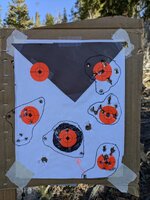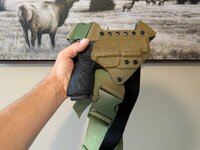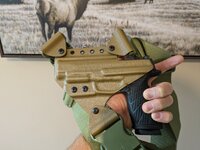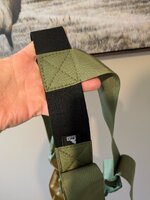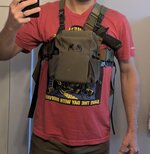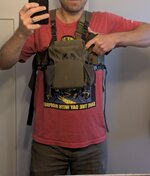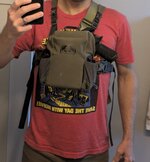RockAndSage
WKR
Some more shooting this morning. Tried to do some dry fire nearly every day the last week.
7 yd, not timed. For 10 rounds I tried target focus with fuzzy sights, which are nearly all outside the black . Doesn't work as well for me. All one eye sight focus are in the black.
View attachment 871691
25 yards, 5 rounds, not timed. One eye front sight focus
View attachment 871692
The FBI qual drill. Not good. I'm not sure the details of scoring but I counted cut line as the higher point. I also estimated the ones outside the ring as 5 or 6, but not sure if that's correct or if they should be 0. My hold was getting pretty shakey by the time I did this. I guess I need to do a lot more dry fire and get my hand and forearm endurance improved. The timing component also makes accuracy much harder.
120 depending on scoring
View attachment 871693
With the soft-focus/fuzzy focus, you can see from your target that you'd still have them all in the chest at 7yds, which isn't bad at all, as long as you keep things in context.
Generally speaking, "soft focus" or a target focus for iron sights is best for very fast and very close, but beyond conversational distances. It does have its place, but it's also something I generally wouldn't really do beyond 7-10 yards, without very pressing and very specific, unlikely circumstances. Below 5 yards, try just covering up the target with the back of your gun's slide. Below 2 yards, it's point shooting. Beyond 10yds it's a kind of flash-focus on the front sight without spending lots of time trying to get everything just perfect, and beyond about 15yds you really need to start carefully focusing on that front sight. There's a window of time and distance where each of these and other techniques becomes more or less useful. But the foundation should definitely be front-sight focus, with the rest of these techniques being add-ons after a solid foundation has been laid.
You won't hear much of this from most instructors in most introductory handgun courses, because of the need to lay that foundation. And because of most guys' predilection for getting way ahead of themselves too early in just about anything we try to learn. That foundation needs to be focused on first, crawling and walking, before trying the stuff that's more running and sprinting.
It's also important to always remember your instructor's zero. Guys coming out of .mil units and guys who spend most of their career on tactical teams will gravitate far more towards front-sight focus or, with red-dots, target focus, because their reality revolves around having the initiative, and knowing when they're going into a gunfight. The sudden fight/flight adrenaline dump doesn't hit them instantly and unexpectedly, as they're usually the ones moving in on a target and starting the gunfight themselves. Guys coming out of deep cover work of various kinds or street law enforcement tend to teach more of the point-shooting variations, taking into account those instant full-bore adrenaline dumps, and how to shoot at arms-length from holstered or concealed, and face-to-far distances. Both of those worlds have different techniques and priorities in moving to cover or through, into, or out of a threat environment - hostage rescue is very different from what matters to officer survival in a suddenly violent traffic stop. Which is something not even on the radar of a high-end competitive shooter, who will teach you how to shoot fantastically well, but not necessarily how to survive a violent encounter. So, always know your instructor's zero, when evaluating what you're being taught and how it may or may not make sense for your situation. Just assemble all the tools you can, and evaluate what's best for a given job.


